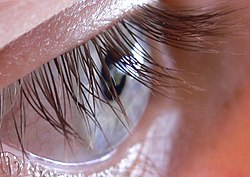Eyelash
This article needs additional citations for verification. (May 2008) |
| Eyelash | |
|---|---|
 Human eyelashes | |
| Details | |
| Identifiers | |
| Latin | Cilia |
| MeSH | D005140 |
| TA98 | A15.2.07.037 |
| TA2 | 7057 |
| FMA | 53669 |
| Anatomical terminology | |
An eyelash or simply lash is one of the hairs that grow at the edge of the eyelid. Eyelashes protect the eye from debris and perform some of the same function as whiskers do on a cat or a mouse in the sense that they are sensitive to being touched, thus providing a warning that an object (such as an insect or dust mite) is near the eye (which then closes reflexively).
The Greek word for eyelash is "blepharis". This word is often used as a root in biological terms (Blepharis, Kathablepharis, etc.)
Human eyelashes
The eyelashes of the embryo develop from the ectoderm[1] between the 22nd and 26th week of pregnancy.[2] Eyelashes take about seven to eight weeks to grow back if pulled out.[citation needed] Their color may differ from that of the hair, although they tend to be dark on someone with dark hair and lighter on someone with light hair.
The follicles of eyelashes are associated with a number of glands known as the glands of Zeis and the glands of Moll.
Cosmetics

Long eyelashes are considered a sign of femininity in many cultures. Accordingly, some women seek to enhance their eyelash length artificially, using eyelash extensions. On the other hand, Hadza women are known to trim their own eyelashes.[3]
Kohl, a black powder (usually antimony sulfide or lead sulfide), has been worn as far back as the Bronze Age to protect and enhance lashes. In Ancient Egypt, it was used as well by the wealthy and the royal to protect their eyes from the sand, dust, and bugs. Modern eye makeup includes mascara, eyeliner, eye putty, and eye shadow to emphasize the eyes. The twentieth century saw the beginning of convincing-looking false eyelashes, popular in the 1960s. There are also different tools that can be used on the lashes such as eyelash curler or mascara shield (also named mascara guard or eye makeup helper).
Permanent eyelash tints and eyelash extensions have also become popular procedures, even in fairly basic salons. It is also possible to get eyelash transplants, which are similar in nature to hair transplantation often done on the head. Since the hair is tranplanted from the hair on the head, the new eyelashes will continue to grow like head hair and will need to be trimmed regularly.[4]
Latisse was introduced in the first quarter of 2009 by Allergan as the first drug to receive FDA approval for eyelash growth. Latisse is a solution of bimatoprost, the active component of the glaucoma medication Lumigan. According to Allergan, noticeable eyelash growth occurs within 16 weeks. Growth is reported to occur primarily on the upper eyelashes. In addition, the past decade has seen the rapid increase in the development of eyelash conditioners. These conditioners are designed to increase the health and length of your lashes. Many utilize seed extract, minerals, and other chemicals to achieve these results.
Health

There are a number of diseases or disorders involving the eyelashes:
- Madarosis is the loss of eyelashes.
- Blepharitis is the irritation of the lid margin, where eyelashes join the eyelid. The eyelids are red and itching, the skin often becomes flaky, and the eyelashes may fall out.
- Distichiasis is the abnormal growth of lashes from certain areas of the eyelid.
- Trichiasis refers to ingrown eyelashes.
- Eyelashes may become infested with parasitic crab louse.
- An external hordeolum, or stye, is a purulent inflammation of infected eyelash follicles and surrounding sebaceous (Zeis) and apocrine (Moll) glands of the lid margin.
- Trichotillomania is a disorder that urges the sufferer to pull out scalp hair, eyelashes, etc.
- Demodex folliculorum (or the demodicid) is a small mite that lives harmlessly in eyelash and other hair follicles, and about 98% of people have these mites living on them. Occasionally they may cause blepharitis.
Eyelash and eyebrow transplant surgeries may be help to reconstruct or thicken lashes or eyebrow hair.
Nonhumans

Lashes, being hair, are found in mammals. Camels' lashes are remarkably long and thick. Horses, cows, and also ostriches (vestigial feathers without barbs) feature eyelashes as well. Inherited eyelash problems are common in some breeds of dogs as well as horses.
Eyelash vipers show a set of modified scales over the eyes which look much like eyelashes. Hornbills have prominent feather eyelashes, an uncommon feature in birds.
References
- ^ Standring, Susan Neil R. Borley (2008). Gray's Anatomy: the Anatomical Basis of Clinical Practice (40th ed.). Edinburgh: Churchill Livingstone/Elsevier. p. 703. ISBN 978-0443066849.
- ^ "Fetal development: MedlinePlus Medical Encyclopedia". Nlm.nih.gov. Retrieved 2013-03-16.
- ^ "Hadza". Encyclopedia of sex and gender: men and women in the world's cultures, Volume 1. New York: Springer. 2003. ISBN 978-0-306-47770-6.
- ^ "Xinhua - English". News.xinhuanet.com. 2006-10-25. Retrieved 2013-03-16.
